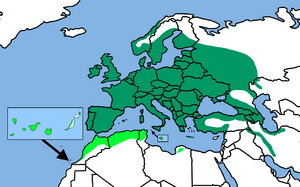Blue tit facts for kids
Quick facts for kids Blue tit |
|
|---|---|
 |
|
| Conservation status | |
| Scientific classification | |
| Kingdom: | |
| Phylum: | |
| Class: | |
| Order: | |
| Family: | |
| Genus: |
Cyanistes
|
| Binomial name | |
| Cyanistes caeruleus |
|
 |
|
The blue tit, Cyanistes caeruleus, is a passerine songbird in the family Paridae. It is 10.5 to 12 cm (4.2 to 4.8 inches) long.
The blue tit is a widespread and common resident breeder. It lives throughout temperate and subarctic Europe and western Asia in deciduous or mixed woodlands. It is a resident bird; most do not migrate.
Contents
Behaviour
Blue and great tits form mixed winter flocks, and the former are perhaps the better gymnasts on the slender twigs. A blue tit will often ascend a trunk in short jerky hops, imitating a treecreeper. As a rule the bird roosts in ivy or evergreens, but in hard weather will shelter in a hole. Blue tits are very agile and can hang from almost anywhere.
The blue tit has an average life expectancy of 1.5 years [1]
Diet
The blue tit is a destroyer of pests. It is fond of young buds of various trees, and may pull them to bits in the hope of finding insects. No species, however, destroys more coccids and aphids, the worst foes of many plants. It also eats leaf miner grubs and green tortrix moths (Tortricidae). Seeds are eaten, as with all this family.
Learning
An interesting example of culturally transmitted learning in birds was the phenomenon dating from the 1960s of blue tits teaching one another how to open traditional British milk bottles with foil tops, to get at the cream underneath. This behaviour has declined recently because of the replacement of doorstep delivery by supermarket purchases of milk, and by hard-topped containers instead of the old bottles.
Images for kids
See also
 In Spanish: Herrerillo común para niños
In Spanish: Herrerillo común para niños







